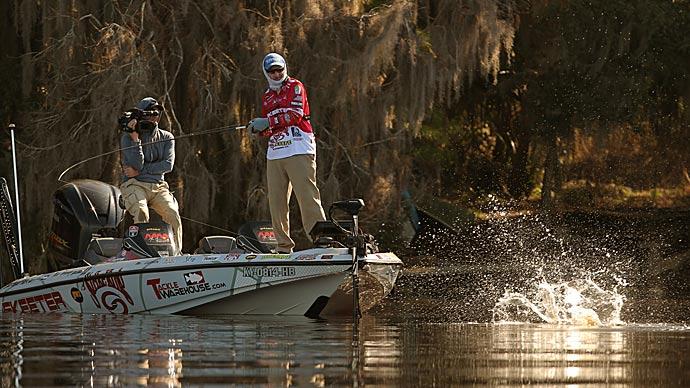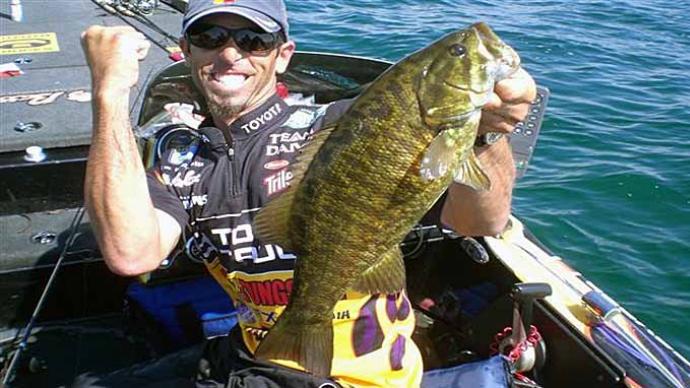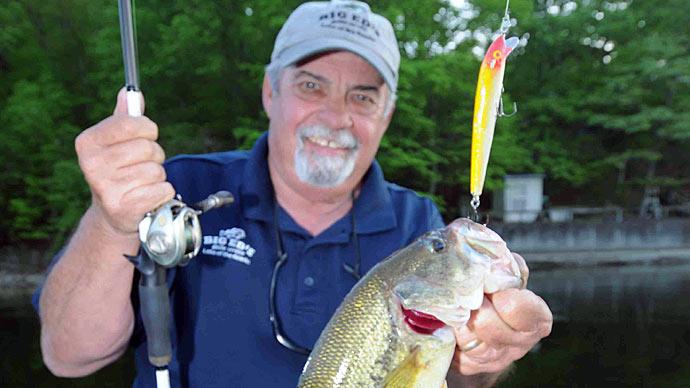
Anyone who knows me will tell you that I'm crazy about jerkbaits. I will throw them until my arm gives out. I have wasted many years of bass fishing by not throwing these baits, especially in clear water. It's incredible how far a bass will travel to smash a wild, moving jerkbait. Give me a big flat with lots of submerged grass, and I will be happy.
I have learned over the years to pay close attention to the retrieve speed. This is more important than color. If you see a bass following the bait but refusing to strike, you must change your retrieve speed. Most of the time, in clear water, you will see followers that turn away. It means you are working the bait too slow. Most of the strikes come as the bait stops. I have watched hundreds of bass strike my jerkbaits over the years, and it's amazing how they will come up from deep water and bust them. I will usually make a relatively short cast and work the bait very fast for a few feet, then let it rise or hover for a few seconds before working it fast again. I always pay special attention as it gets close to the boat. That's when a lot of strikes occur. I watch below the bait in clear water for a "dark spot" closing in. I usually make a couple of fast jerks with my wrists, then "kill the bait, and it will trigger a strike.
I use a Husky Jerk most of the time. I have tried many jerkbaits, and this one has the most action of any hard bait I have ever seen. When the fish don't want the hard bait, I throw a Zoom Super Fluke rigged with a good 4/0 extra wide gap hook.
I like a 1/16-ounce Florida rig weight because you screw the weight into the nose of the bait. This provides a little extra weight to cast but allows you to work it quickly on the top and then kill it when it approaches the edge of the grass or cover.
I have also been using a Gary Yamamoto Senko. This bait is great. It may not look like much, but the action is unreal.
Some soft plastic jerkbaits are heavy enough to cast and will catch bass like crazy. If you need a little extra weight with the bait, push a nail weight into the tail, and it will fall tail first and still has superb action when jerked. I fish these soft jerkbaits on top when the bass are willing to rise and strike. At other times, they work excellent on a Carolina rig. I always have a Super Fluke or Senko rigged during the summer months on a mini-Carolina rig. I use only a 1/4-ounce weight when doing this, just enough weight to get on top of the deeper grass without digging into it. If your back seat partner does this and drags it behind the boat as you cast your arms off in front, you will probably be out-fished.
Most of the hits on a Carolina-rigged jerkbait will be good solid hits, not those little mushy taps we try to feel for. I use 12- or 14-pound green Trilene line for all types of jerkbait fishing. Maybe it's just me, but I get more strikes with the green line. Whatever gives you confidence will help your fishing. At other times you will find the bass want the jerkbaits with no action. I have caught a lot of good bass by just "dead sticking" a fluke on top of submerged grass. It may sound crazy, but sometimes that's the trick.
Try to parallel the edge of a submerged grass bed and let the bait sit on the edge. Sometimes that's all it takes to make a difference. As for colors, I keep it fairly simple. If I am going to be working a soft jerkbait fast, I like to use white, so I can easily see the bait. This works well when the water is calm and nothing is biting. This is simply a reaction strike. Of course, on calm, clear water, you will need to make a longer than a typical cast and work it fast. When working these baits fast, it helps to place a swivel about 18 inches above the hook, as you can get some line twists. Of course, with a long cast and fairly light line, make sure your hooks are sticky sharp, and the hook is pushed through the bait, then lightly pushed under the skin of the bait.
If I am fishing a little slower and deeper, I like to use watermelon or a baby bass colors. I will sometimes dye the tail chartreuse. It seems to help me.
Another trick that sometimes works is simply hanging a small tube lure weight on the hook itself. After you run the hook through the head of the bait, place a 1/16- or 1/8-ounce weight over the hook point before burying the hook point into the bait. Drop it in the water next to the boat and watch it fall perfectly horizontally. It will fall with a slight little wiggle when it is rigged correctly. Again, the light line helps this rig also. Cast it next to cover or grass and let it fall on a fairly slack line. Bass will carry it off like a suitcase full of money. I have made these weights from a small barrel swivel. Just crimp a round spilt shot over the eye of one end of the swivel, and your weight is ready to hang over the hook. Very simple and works great.
I have tried every way imaginable to use a jerkbait, from tying them behind a Spook to rigging a fluke like a wacky worm. It works pretty good with a little weight in the head. It falls and looks like an injured shad. I like to use the Husky Jerk when searching for fish. You can cover some water in a hurry. Once I catch a few fish in an area, I like to go back over it with a soft jerkbait and fish a little slower. If I catch a few more fish, I will go over it again with a mini Carolina rig. I have noticed jerkbaits catch fish in areas that do not look productive to us as fishermen. I mean barren banks and places you usually wouldn't fish with other baits.
The next time you are out fun fishing and see some guys burning the banks with spinnerbaits, try following them with jerkbaits. One person works fast and shallow, and the other person drags one under the boat. I have so much confidence in jerkbaits that I don't mind fishing areas with boats all over the place.
I know that 90 percent of the other guys will be chunking spinnerbaits, crankbaits, and worms. This type of fishing requires some degree of patience. Get the thousand-casts-a-day syndrome out of your head. Instead, try to make fewer but more effective casts. If you are lucky enough to have good shoreline cover, try dead-sticking a soft plastic jerkbait or fluke right in the middle of the cover. Make a short pitch into the cover, and let it slowly fall between the limbs. With the lighter line, you may break off. But if you can't hook em, you can't catch 'em.
Using big line with this type of fishing takes away a lot of the action from the bait. I will take my chances and re-tie as often as needed with lighter line. When choosing a rod action for jerkbaits, I suggest sticking with a medium action. You want a fairly light tip to cast light baits, but you will also need a strong butt section to get them turned and coming in your direction. If you use jerkbaits occasionally but still have no confidence in them, then by all means, get out and give them a fair chance. They will work year-round from top to bottom in all depths and water color.
Remember, you can't fish them too fast or too slow. So try it all and let the bass tell you what they want.




